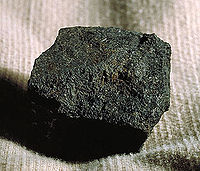
Photo from wikipedia
Intra-annual wood density fluctuations are valuable indicators of the role of the local climate and provenance origins on tree growth. These intra-ring wood features were the most informative about local… Click to show full abstract
Intra-annual wood density fluctuations are valuable indicators of the role of the local climate and provenance origins on tree growth. These intra-ring wood features were the most informative about local adaptation and phenotypic plasticity ofPinus halepensisMill. in a provenance trial. This highlights the importance of taking provenance into account when selecting forest reproductive material to mitigate the effects of climate change. It is essential to disentangle the influence of climate from the effect of provenance on inter- and intra-annual wood traits to identify populations’ responses to climate changes. This will be even more relevant in the drought-prone Mediterranean region, where species have high genetic differentiation among populations. We investigated the effects of provenance and climate driving Pinus halepensis Mill. wood traits, as imprinted phenotypic adaptations to the Mediterranean climate. Inter- and intra-annual wood trait variation (ring-, early-, and latewood width, wood density) was studied by microdensitometry in 8 provenances from Spain, France, Greece, and Italy in a common-garden experiment. We related wood traits and density fluctuations with inter-annual climate variations at the trial site and the provenance origin. Provenances showed distinct responses to climate regarding tree growth, wood density, and intra-annual fluctuations. Density fluctuations in latewood were more frequent than in earlywood. Climate at the provenance origin was a more important force for density fluctuations than climatic variations at the planting site, with different trends between coastal and inland provenances, and higher frequency of latewood fluctuations in provenances from arid and semiarid sites. Differences in P. halepensis wood density fluctuations confirmed the imprinted origin provenance control in response to climate variations and indicated a relation with local adaptation of these xylem anatomical features. Moreover, the position of these fluctuations in rings reflected the high plasticity of P. halepensis to cope with high intra-seasonal variability of climatic conditions. This underlines the importance of considering tree-ring features for the selection of provenances in reforestation material for conservation and silvicultural programs.
Journal Title: Annals of Forest Science
Year Published: 2020
Link to full text (if available)
Share on Social Media: Sign Up to like & get
recommendations!